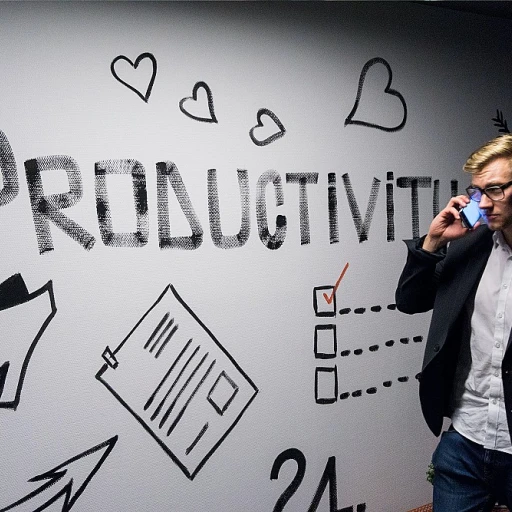Understanding Why Employees Leave
Identifying the Root Causes of Employee Turnover
In order to implement effective retention strategies, it's essential to first understand the underlying reasons why employees decide to leave a company. This often involves a multifaceted analysis of various factors that can influence an employee's decision to seek opportunities elsewhere.
One major factor that often instigates an employee's departure is the lack of alignment between personal goals and the company's objectives. When an employee does not see a clear path for personal growth or advancement within the organization, the appeal of external opportunities intensifies. This misalignment can stem from a lack of communication from management or insufficient career development initiatives.
Additionally, compensation and benefits packages play a significant role in employee loyalty. Companies that fail to offer competitive salaries or comprehensive benefits might find themselves at risk of losing valuable team members. However, it's crucial to consider that job satisfaction isn't solely determined by financial incentives. Non-monetary factors such as company culture, management practices, and work environment heavily impact an employee's tenure as well.
Indeed, the regular occurrence of job-related stress, excessive workloads, and rigid work hours often leads to burnout, prompting employees to look for a healthier work-life balance. This aspect of employee satisfaction will be explored more deeply in the subsequent section.
Understanding these reasons is the foundation of retaining a talented workforce. By acknowledging the necessity of a tailored approach to employee retention, businesses can work towards creating an environment where employees feel valued, supported, and motivated to grow alongside the organization. This groundwork is essential as we move on to explore how to craft a strong company culture, a critical pillar in retaining talent across industries. For a deeper dive into ensuring your team feels appreciated and committed, check out how
keeping employees happy can enhance your retention efforts.
Crafting a Company Culture That Retains Talent
Building a Culture of Trust and Respect
Establishing a company culture that actively encourages employee retention requires more than just implementing surface-level perks. Trust and respect are essential cornerstones. Employees are more likely to stay with a company where they feel their contributions are valued and their voices heard. This can be nurtured by offering platforms for open communication, promoting inclusive decision-making processes, and implementing transparent practices across all levels of the organization.
Investing in Professional Development
In today's ever-evolving job market, opportunities for professional growth are crucial. Companies should focus on offering continuous learning and advancement pathways. This not only enriches the individual's skill set but also enhances company loyalty, as employees are less likely to seek job changes when they see a clear trajectory for growth within the organization.
Fostering a Sense of Belonging
A healthy company culture is one where employees feel they belong. Initiatives that promote team bonding, celebrate diversity, and recognize achievements can help solidify this bond. Such efforts improve workplace morale and create an environment where employees look forward to coming to work every day.
For more insights on creating such an environment, check out this
guide on mastering employee retention in HR, which provides deeper strategies for fostering loyalty through an optimal company culture.
The Role of Work-Life Balance in Employee Retention
Fostering a Work-Life Harmony for Retention
The delicate balance between work and personal life has gained significant attention in recent years. Companies striving to maintain high employee retention rates have come to understand that offering a harmonious work-life balance is not just a perk but a necessity. By acknowledging this need, businesses can position themselves as forward-thinking employers who truly understand and cater to their team’s well-being.
One effective approach is to offer flexible working arrangements. Whether it's remote work options or flexible working hours, these arrangements give employees the autonomy to manage their time in a way that suits their individual lifestyle. This not only reduces stress but also enhances productivity, leading to a satisfied and loyal workforce.
In addition, consider implementing policies that encourage taking breaks and prioritizing mental health. Encouraging employees to step away from their desks, even for a short walk or to enjoy lunch without interruptions, can significantly reduce burnout and foster a more relaxed, yet efficient, work environment.
Another innovative way to promote work-life balance is by offering personalized benefits. Tailoring benefits to meet the diverse needs of your employees, such as child care support or wellness programs, can significantly impact their overall job satisfaction.
Organizations should also foster an open dialogue around workload management. Encourage managers to check in with their teams regularly to ensure workloads are manageable. This proactive approach can help identify potential stressors before they become problems, ultimately supporting a positive work-life balance culture.
As part of cultivating a robust company culture and boosting employee satisfaction, which we delved into earlier, integrating work-life balance into your retention strategy is a vital step. For more insights into creating such an environment, you can explore additional strategies in this
comprehensive guide.
Enhancing Employee Engagement and Experience
Creating a Meaningful Employee Experience
In the quest to enhance employee retention, fostering a meaningful experience for your team is crucial. Employees who feel valued and engaged are more likely to remain loyal to their organization. To achieve this, it's important to focus on cultivating an environment that makes employees not just satisfied, but truly connected to their work.
One approach to enhancing the employee experience is to prioritize open communication and feedback. Encouraging regular dialogues between management and staff can lead to a more transparent and trusting workplace. Employees who feel heard are more inclined to be engaged and perform better, knowing that their opinions are valued and their contributions recognized.
Professional development opportunities also play a significant role in employee engagement. Offering pathways for career advancement and learning allows employees to see a future within the company. Supporting continuous growth keeps employees motivated and invested in their career paths, reducing the likelihood of them seeking new opportunities elsewhere.
Furthermore, it's essential to recognize the power of acknowledgment. Regularly celebrating achievements, whether big or small, can significantly boost morale. Through rewards, recognitions, and incentives, employees feel appreciated and driven to continue their efforts for the organization's success.
Lastly, implementing flexible work arrangements can enhance the employee experience by aligning work to fit individual lifestyles. Offering options such as remote work or flexible hours can lead to increased job satisfaction as employees balance their professional obligations with personal needs effortlessly.
By focusing on these key elements, companies can create a workplace where employees feel included, challenged, and motivated. This in turn leads to improved retention rates, ensuring that your organization retains its top talent and continues to thrive.
Retention Strategies That Work
Flexible Work Arrangements and Perks
One of the key strategies to retaining top talent is offering flexible work arrangements and attractive perks. Employees today seek workplaces that understand their individual needs and provide options that allow them to balance their personal and professional lives effectively. By offering remote work options, flexible working hours, or compressed workweeks, organizations can cater to the diverse preferences of their workforce. These measures not only enhance employee satisfaction but also contribute to improved productivity, as individuals are likely to perform better when they are not constrained by rigid schedules.
Recognition and Career Development Opportunities
Providing recognition and career development opportunities is another critical aspect of successful retention strategies. Employees who feel appreciated and see a clear path for advancement are more likely to remain committed to the company. Implementing regular performance reviews, offering mentorship programs, and providing educational resources or tuition reimbursement can motivate employees to grow within the organization. This focus on development addresses the reasons employees might leave, as outlined in earlier discussions, and reinforces a culture that values each individual's contributions and aspirations.
Fostering Open Communication
Transparent and open communication within a company cultivates trust and loyalty among employees. Establishing channels for employees to voice their opinions and concerns, and ensuring that their feedback is valued and acted upon, creates an environment where individuals feel heard and understood. Regular one-on-one meetings with managers, employee surveys, and suggestion boxes are effective tools for fostering this kind of communication. This approach not only aids in understanding why employees might consider leaving but also actively involves them in building a workplace they are enthusiastic to be a part of.
Implementing a Comprehensive Onboarding Process
A comprehensive onboarding process can significantly influence employee retention rates. Providing new hires with a detailed introduction to the company culture, clear expectations, and necessary resources equips them for success from the start. A well-structured onboarding program can reduce the initial stress that employees might face, thus decreasing the likelihood of early turnover. This strategy connects back to crafting a company culture that retains talent, as the initial impression set by the onboarding process can resonate throughout an employee’s tenure.
Analyzing and Adapting Retention Strategies
Finally, continually analyzing and adapting retention strategies ensures that your efforts remain relevant and effective. The business environment and employee expectations are constantly evolving, so it's crucial to regularly review your strategies to make necessary adjustments. Conducting exit interviews, analyzing exit data, and staying updated with industry trends can provide valuable insights into the effectiveness of your current retention efforts and highlight areas for improvement.
Implementing these strategies collectively composes a robust approach to retaining your valuable employees and is critical in the pursuit of fostering a resilient, loyal workforce.
Measuring Success: Calculating Employee Retention Rates
Measuring the Success of Your Employee Retention Strategies
It's essential to understand how effective your employee retention strategies are, and measuring success through calculating employee retention rates can provide insight into your efforts' efficiency. Monitoring these numbers allows organizations to make informed decisions and adjustments to their retention plans.
Begin by calculating your employee retention rate using the following formula: the number of employees who remain with the company over a specific period, divided by the total number of employees at the start of that period, multiplied by 100. This rate gives you a percentage that shows how well you're retaining your workforce.
However, while the retention rate offers a snapshot, it shouldn't be the only factor you rely on. Examining turnover rates and understanding why employees depart is crucial. By incorporating insights from understanding employees' reasons for leaving, as discussed earlier, you can paint a more complete picture of your retention strategy's success.
Furthermore, fostering a company culture that retains talent, as well as embracing work-life balance, significantly impacts these metrics. Look at various aspects, such as employee engagement scores, satisfaction surveys, and feedback loops, to gauge the workplace environment and how you might improve it.
Enhancing the overall employee experience through these strategies can yield increased retention rates and foster a loyal, committed workforce. By aligning various retention techniques and assessing them regularly, companies are better positioned to retain their valuable talent efficiently.












